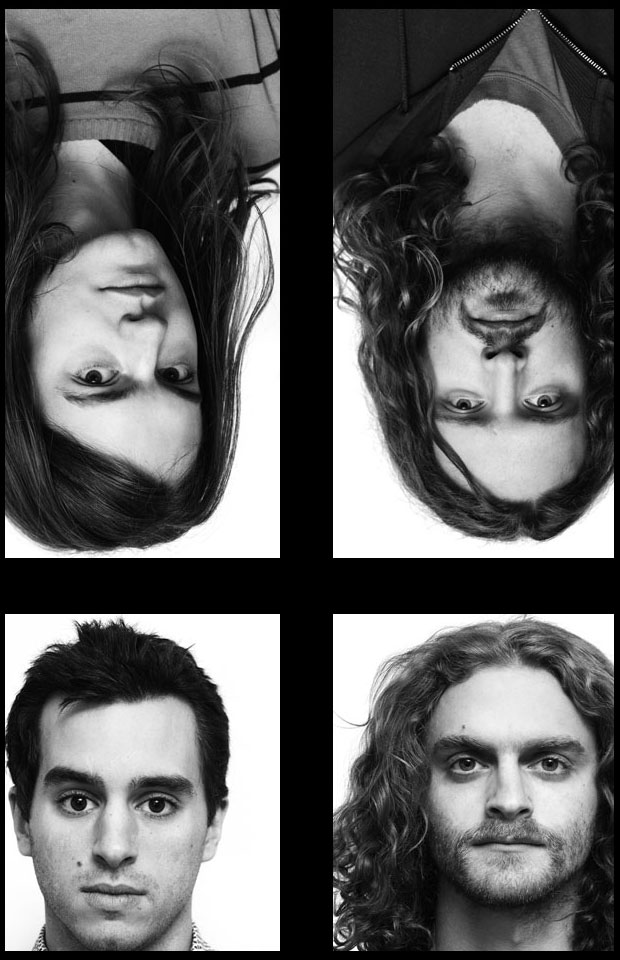|
 Dark Angels
Dark Angels
Liturgy / Aesthethica (Thrill Jockey)
Okay, you’ve all heard about black metal,
so you know that when we call Liturgy a black metal band we gotta think
sixsixsix times about our accuracy on that, because all those true BM
aficionados might get offended and burn down our church! Seems that the
experimental-leaning Liturgy is messing with the metal “form” too much
for our hairy purist brethren, and anyway, ain’t they just a bunch of
Brooklyn college kid poseurs? Nah, they’re not. Though as
slab-thick-riffalicious and blast-beat bombastic as the gnarliest and
gruesomest of black metal beasts, from the git-go Liturgy wanted to take
you higher, to do something…different. And different is what they are.
Transcendental, too.
Comprising
Hunter Hunt-Hendrix on lead screech and guitar, Bernard Gann on second
guitar, human octopus Greg Fox on AK40 drums and Tyler Dusenbury on bass,
Liturgy make a new kind of music that may or may not qualify as black
metal, though the band themselves apparently they could really give a
flying fork.
“As
far as the ‘black metal’ label goes,” says Dusenbury, “the question of
authenticity in certain realms is important, but it’s more important for
things like visual art and ethnography. When it comes to music, it’s just
fluid –– like clusterfucks. Genre is irrelevant.”
You can blame the black metal label on Hunt-Hendrix,
‘cause it was all his idea, originally, he thought it might as well be
niche-marketed that way, if only to get the music heard at all.
“When Hunter first started the band to make the first album,
Renihilation,” says
Dusenbury, “we had just gotten together two months before, and when we
went into the studio, we sort of whipped out all the songs he had
written, just banged ‘em out over a few days. So we didn’t really have
time to think about what we were doing.”
A
ferociously feral speed-thrash grand grindcore guignol nicely lacking
lyrical references to the horns of the goat or the bony finger of doom, Renihilation was close enough to true black metal to
earn the grudging respect of a handful of BM traditionalists and approx.
three metric tons of rock critics more excited about the band’s casual
disregard for the de rigeur sonic clichés of the “genre.”
“Black metal is the kind of music that people identify very
heavily with in a lifestyle way,” says drummer Fox. “People are defined
by the fact that they like black metal, they live for it, and sometimes
their reactions to us are kind of violent. It’s the kind of stuff I
remember some jocks saying in high school.”
For the band’s new Aesthethica, Hunt-Hendrix came to the table with
material going even further in dissonant directions, hardcore at core,
yet heavier in the theoretical sense, a fearsomely assaultive yet
cathartic brand of rhythmic trance music whose direction/aesthetic takes
its formal cues from the new-music likes of Steve Reich, Glenn Branca,
Rhys Chatham and the almighty Lightning Bolt. Drawing further inspiration
from a wide array of non-rock sources including the 11th-century
chants of Perotin, the writing of William Blake, the music of Scriabin
and the films of Alejandro
Jodorowsky, Liturgy takes metal music into ecstatic realms with the
use of repetitive riffs and lines pummeled and flayed, densely interwoven
and moiré-patterned unto infinity; meanwhile, Hunt-Hendrix is screaming,
he’s groaning, he’s glossolating like he’s suffered for his art and now
it’s our turn.
The catharsis of Liturgy is the kind that
comes from having endured prolonged intervals of extreme discomfort. You
get a similar entrancing experience from Moroccan gnawa music or your old free-jazz-type things
such as Ornette Coleman’s Primetime band, where there’re at least two
possible levels of interpretation: inspect the music up close like you
would a Persian rug, or view it as some particularly intense wallpaper
from a little farther away. It puts you in a different place –– somewhere
above the music itself. There’s a kaleidoscopic mental and arguably
spiritual effect to the band’s precisely detailed aural assault, a very
methodical madness to this sound that might as well be called black metal
yet is really no less than the most modern and relevant of all electric
chamber musics. 
|